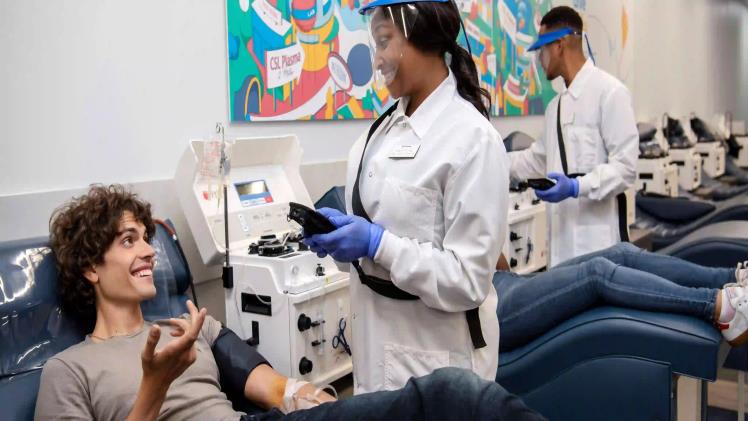Discovering the Benefits of Calexico Plasma Donation

Understanding Plasma: The Liquid Gold of Our Bodies
Plasma is often referred to as the “liquid gold” of our bodies, and for good reason. Comprising around 55% of total blood volume, plasma is a yellowish fluid that plays a crucial role in transporting nutrients, hormones, and proteins to the respective parts of the body. This essential component of blood is primarily made up of water (about 90%), with the remaining 10% consisting of various proteins, electrolytes, and metabolic waste products. The proteins found in plasma, including albumin, globulins, and fibrinogen, are responsible for several important functions, such as maintaining blood pressure, immune responses, and blood clotting. Given its multifaceted functions, it is no surprise that plasma is deemed invaluable in medical contexts, especially in treating various ailments.
The Science Behind Plasma: What Makes It So Valuable?
The value of plasma lies not only in its composition but also in its versatile applications in medicine. Plasma contains clotting factors, which are critical for patients suffering from bleeding disorders, and immunoglobulins that bolster the immune system. The creation of therapies from plasma donation involves complicated processes that isolate these components for medical use. For instance, factors derived from plasma are used in treating hemophilia, while immunoglobulins are pivotal in conditions that require immune support. Advanced therapies for conditions such as burns, shock, trauma, and chronic diseases like hepatitis or autoimmunity find their roots in plasma components. This reliance on a resource that is replenishable through healthy donations emphasizes the collective responsibility of communities to support such initiatives.
The Role of Plasma in Modern Medicine: A Lifesaving Resource
Plasma donation has evolved into a cornerstone of modern medicine, with applications ranging from emergency care to long-term therapies. Every year, millions of patients worldwide benefit from life-saving therapies developed from plasma. From burn victims in need of wound healing to individuals with rare blood disorders requiring clotting factors, the demand reflects an increasing need for accessible plasma. Moreover, the advent of new technologies has expanded the horizons of plasma applications. For instance, advancements in therapeutic apheresis have revolutionized how certain autoimmune diseases are treated by selectively filtering and removing plasma constituents that escalate disease symptoms. As the medical field continues to advance, the potential use cases for plasma are bound to grow, further solidifying its status as a lifesaving resource.
Myths and Facts: Debunking Common Misconceptions about Plasma
Many misconceptions surround plasma donation, often deterring potential donors from engaging in this life-affirming act. A prevalent myth is that donating plasma is painful and significantly more involved than donating blood. In reality, while there may be slight discomfort associated with the needle insertion, the procedure itself is generally tolerable and lasts about an hour.
Another common belief is that individuals can only donate plasma if they are well-educated or possess specific qualifications. This is far from the truth; anyone who meets basic health criteria can become a donor. Additionally, it is essential to dispel the myth that plasma donation negatively affects one’s health. On the contrary, regular donation promotes the body’s natural regenerative capabilities, enhancing overall well-being. By educating the public about these misconceptions, we can encourage more individuals to consider plasma donation, ultimately saving lives.
Calexico’s Role: A Hub for Plasma Donation
Calexico, a small city nestled on the US-Mexico border, has emerged as a pivotal player in the plasma donation landscape. Its unique geographical position provides an excellent opportunity for outreach to individuals from diverse backgrounds, all sharing a common goal of contributing their plasma to help those in need. By positioning itself as a hub for plasma donation, Calexico enhances the accessibility of this essential resource not just for local residents but for the broader community as well.
Why Calexico? The Unique Advantages of Donating Here
The advantages of donating plasma in Calexico extend beyond the immediate act of donation. For starters, the donation centers are often equipped with state-of-the-art technology that ensures donor safety and comfort. Many facilities provide a welcoming atmosphere, including amenities like comfortable seating, entertainment options, and refreshments to ease the experience. Additionally, Calexico’s strategic location allows for collaboration between US and Mexican medical facilities, facilitating a cross-border exchange of healthcare resources. Therefore, donations made in Calexico can directly impact patients on both sides of the border, maximizing the benefit of each contribution. Furthermore, the sense of community in Calexico amplifies the impact of donations, fostering a culture of altruism that encourages residents to participate actively in enhancing public health.
The Community Impact: How Your Donation Makes a Difference
The community impact of plasma donation in Calexico is profound and multifaceted. Every plasma donation contributes to a larger pool of resources that can be used to create life-saving treatments. This is particularly crucial given the proximity to Mexico, where access to such therapies can be limited for many families. Local hospitals and clinics can source plasma-derived products quickly and efficiently, enabling them to cater to patients in urgent need. Additionally, the act of donating serves as an inspiration for community members to become more engaged in other health-promoting activities, from blood drives to health education campaigns. By transforming the understanding of plasma donation as a communal effort, Calexico cultivates a spirit of solidarity among its residents, uniting them in addressing health challenges faced by their neighbors.
Behind the Scenes: The Plasma Donation Process in Calexico
Calexico plasma donation is rigorously designed to ensure safety and efficiency for both donors and recipients. It begins with a thorough screening process where potential donors are asked about their medical history, current medications, and lifestyle factors that could affect eligibility. This screening is crucial to ensure that only healthy individuals donate plasma, thereby safeguarding both their health and the well-being of plasma recipients. Once deemed eligible, donors undergo the donation process, where a specific quantity of plasma is collected via a sterile machine that separates plasma from other blood components. After donation, individuals are closely monitored and given the opportunity to rest and replenish lost fluids before they leave. Understanding this well-structured process can minimize apprehensions surrounding plasma donation, encouraging more individuals to step forward and contribute their vital resources.
Health Benefits of Donating Plasma: A Win-Win Situation
Many people consider plasma donation solely a charitable act; however, it also presents a wealth of health benefits for the donors themselves. Engaging in this practice promotes not only a sense of well-being from helping others but also enhances physical health in several notable ways.
Pumping Up Your Health: The Positive Effects on Donors
Donating plasma has surprising health benefits that extend well beyond altruism. Regular plasma donation can help donors regulate their blood pressure and enhance cardiovascular health. Studies have shown that the act of donation can stimulate the production of new blood cells, resulting in improved circulation and oxygen transport within the body. Moreover, the process of donating plasma can lead to lower iron levels, which is essential for individuals prone to conditions like hemochromatosis where excess iron can pose serious health risks. Additionally, donors often report experiencing a ‘feel-good’ sensation immediately after donating, driven by the endorphins released in the process. For those looking to boost their overall health consistency, the act of donating plasma can be an excellent addition to their well-being regimen.
Contributing to Your Community: More than Just a Good Deed
Donating plasma is undoubtedly a profound way to contribute to community health and well-being. Apart from the physical health benefits, there is an emotional and psychological aspect to the act of donating that fosters a sense of connection and belonging. Beyond just the individuals who benefit directly from plasma-derived therapies, the ripple effect of donation extends to families, caregivers, and entire communities. Many donors report feeling empowered by their contributions, often fostering a greater awareness of health issues affecting their neighbors. By cultivating a culture of giving through plasma donation, Calexico communities reinforce the values of compassion and support, creating a network of individuals who look out for one another.
Financial Incentives: How Plasma Donation Can Boost Your Wallet
While the primary motivation for plasma donation is often altruism, it’s worth noting that there are tangible financial incentives involved. Donation centers typically offer compensation for the time and effort expended during the donation process. This can range anywhere from $20 to $50 per session, depending on various factors such as location and frequency of donations. Many donors find that this supplementary income can be beneficial, particularly for students or those facing temporary financial difficulties. Ultimately, the blend of contributing to an essential health resource while receiving financial incentives acts as a compelling motivator for many, making plasma donation a truly win-win situation.
Getting Started: Your Journey into Plasma Donation
Starting your journey into plasma donation is both an admirable and straightforward process. Those interested in making a difference through plasma donation should be informed, prepared, and aware of the entire procedure.
What to Expect: The Step-by-Step Process of Donation
When you decide to donate plasma, the experience is generally structured to ensure both comfort and efficiency. The first step is the pre-donation screening, which evaluates eligibility based on health history and lifestyle. Once cleared, donors are welcomed into a donation space where they will sit in a reclined position for about 45 minutes to an hour. During this period, a sterile needle is inserted, and blood is collected through a specialized machine that separates plasma from red blood cells and platelets. The collected plasma is safely stored, while the remaining components are returned to the donor’s bloodstream. Post-donation, donors are urged to relax and hydrate to replenish lost fluids and improve recovery. This step-by-step guide can help mitigate any apprehensions regarding the process, emphasizing its safety and reliability.
Preparation Tips: How to Ready Yourself for Your First Donation
Preparing for your first plasma donation is crucial to ensure a smooth and pleasant experience. Donors should aim to stay hydrated by drinking plenty of water leading up to the appointment, as adequate hydration ensures optimal plasma volume. Consuming a balanced meal rich in protein and iron before the donation can also be advantageous. Additionally, it’s advisable to avoid alcohol and intense physical activities on the day of your donation. Wearing loose-fitting clothing that allows easy access to your arms can facilitate the process. Lastly, it’s essential to bring proper identification and any required paperwork to expedite the screening process. With these preparation tips in mind, you can enter your first donation with confidence and peace of mind.
Frequently Asked Questions: Clarifying Your Concerns About Donation
As with any medical procedure, potential donors often have numerous questions and concerns regarding plasma donation. Common inquiries include, “Is it safe to donate plasma frequently?” Yes, most donation centers recommend that donors wait at least 48 hours between donations and do not exceed twice a week. Another question pertains to the impact of donation on one’s health. Donors are carefully screened for any conditions that may contraindicate plasma donation, and healthy individuals typically experience no adverse effects. Concerns about pain are common, but many find the donation process to be more uncomfortable than painful, with sensations often described as mild. Ultimately, bridging the knowledge gap through addressing frequently asked questions can eliminate barriers and encourage more individuals to consider plasma donation as a meaningful contribution to community health.



